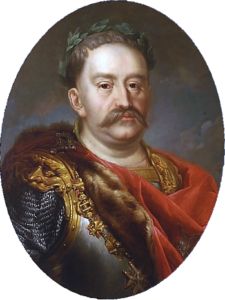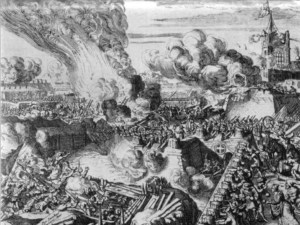Prelude to the campaign
The siege of Vienna is closely connected to the history of the Hungarian-Ottoman wars, moreover, it cannot be discussed out of context. Some people tend to ignore the fact that without a high-ranking Hungarian aristocrat, the Ottoman army could never have reached the walls of the so-desired golden apple, Vienna. It was Thököly Imre (1657-1705) whose family had promptly been alienated by the greedy Habsburg court. It was his successful uprising that gave a chance for the Ottomans to target Vienna.

We know that the Ottomans became aware of his rise, and Grand Vizier Ibrahim, the Pasha of Buda offered him military aid in 1681. Soon, he became the lord of the entire Upper Hungary, and Pozsony (Pressburg, Bratislava) opened its gate before him in July 1683. It enabled the Ottoman army to march to Vienna, unhindered. Thököly was ordered to join the besiegers but he flatly refused it, though. He thought that the Turks would eventually take Vienna but after plundering it, they would withdraw, similar to the case of Buda castle in 1526.

He was anticipating balancing the power between the Habsburgs and the Ottomans and weakening both empires. All in all, he wanted to liberate Hungary for himself, getting rid of both the Ottomans and the Habsburgs in the end. However, Vienna has never fallen to the Turks. Yet, we all know that it would have certainly fallen without the help of the Polish King Sobieski. It is a pity that we cannot find a statue of him in Vienna to commemorate his deed.

Before we talk about the final battle, we must shed the light on a lesser-known fact. Namely, that Thököly had an offer, proffered not for the first time, to the Military Council of Vienna. It was on 4 September that Thököly offered peace and his 25,000 soldiers to Vienna if the Habsburgs were willing to grant him to keep Pozsony (Pressburg, Bratislava) and the Mining Towns of Upper Hungary. Duke Charles of Lorraine supported this idea but his rivals in the Military Council turned the offer down.

The Turks defeated the Imperials on 7 July 1683 at Petronell-Carnuntum, 50 km East of Vienna

Grand Vizier Kara Mustafa launched a campaign against Hungary and Vienna in 1683 that was larger than ever before. The Ottoman army was joined by the “kuruc” (anti-Habsburg rebels) of Thököly and the soldiers of the two Romanian Voivodes, together with the Transylvanian forces. This huge army was advancing relentlessly, and by the beginning of July, they had managed to take the defenses built on the Rába River. They also crossed the river.

As the Ottomans approached Vienna in 1683, young Ludwig Julius, a knight of the House of Savoy, was given command of a new dragoon regiment. His mission was to protect a supply convoy near the town of Petronell on the Danube. The rapid Tatar attacks made it increasingly difficult to protect the convoy, and in one such raid a few days earlier, Luigi Marsigli, a later famous cartographer, soldier, and traveler, who was at the front at the time, was captured and taken away.

The Crimean Tatar cavalrymen managed to catch up with the cavalry of Eugene of Savoy at Petronell on July 7. The Imperials could only stop them at great cost, losing many soldiers in the battle. Some Crimean Tatars overran the Imperial rearguard, which was thrown into chaos before Charles V managed to save the situation. One of the Imperial casualties was the 24-year-old volunteer Ludwig Julius de Savoie, owner of the Savoy Dragoon Regiment, the older brother of Prince Eugene. The dust raised by the tumult of battle made it impossible to distinguish friend from foe, and the unfortunate Savoyard was killed under the hooves of the dragoons of his regiment. His horse fell on him, breaking his ribs, and he died of his injuries in Vienna on the 13th.

This led Eugene to flee Paris a few weeks later without Louis XIV’s permission and join the Imperial Army under the protection of his cousin Ludwig Wilhelm of Baden. He wanted to enter the service of Emperor Leopold. He hoped to get his brother’s former regiment, but this did not happen.
After this, Charles of Lorraine, the supreme commander of the Imperial forces, ordered his troops to withdraw. With no other natural barriers defending Vienna, panic broke out in the city.

The news of the battle reached Vienna and caused panic. The inhabitants ran to the imperial palace and saw Emperor Leopold flee in the evening with his family and members of his court, guarded by soldiers. The citizens begged him to stay. The Emperor’s escape route was threatened by the raiding Crimean Tartars, but he was able to reach Linz unharmed. On July 7, Ernst Ruediger von Starhemberg arrived in Vienna. He was put in charge of the defense of the city and immediately began to strengthen the defensive lines.

Fortunately, the Grand Vizier did not arrive in Vienna until July 14, and the city was not surrounded until July 17.
This was enough time for the defenders to stop the panic and take the necessary measures. This was the reason why the city was able to endure the following two months of siege, waiting for the arrival of the winged hussars…
In the decisive fight that ended the siege of Vienna, the Imperial and the Polish armies defeated the Ottoman army
After a long siege, the defenders of Vienna were getting ready for the final general attack of the enemy. Half of the Christian soldiers were wounded and could not fight, and they were running out of food and gunpowder. They sent signals by shooting rockets from the tower of the Stephankirche to seek urgent help from the eventual reinforcement. The united army of Duke Charles and the Polish King Jan Sobieski was gathering at Tull, with 65,000 men and 150 cannons. They set out on 9 September, marching in battle order along the Danube River. They took Wienerwald on 11 September and it enabled them to occupy the higher ground above Vienna.

Their army took up positions on Kahlenberg Hill. The Imperial troops stood on the left wing, led by Duke Charles, and the troops of the Saxon Elector, Johann Georg III were with him, too. The Franks, Bavarians, and the Swabians were deployed in the middle, under the command of the Bavarian Elector, Maximilian Emanuel. The Hussars of Sobieski (he was the Chief General) stood the farthest from the Danube, on the right wing. We could find about 400 Hungarian Hussars in Duke Charles’ army, led by Palatine Esterházy Pál.

Kara Mustafa Pasha left part of his army around Vienna to keep an eye on the garrison of the city, in case they would sally. Yet, he was just weakening his forces with this. He lost lots of soldiers during the siege already so he could send only about the same size of an army against the Imperial reinforcement. The Ottoman commander deployed the troops of the Pasha of Buda and the Pasha of Diyarbekir on the right wing, opposite the Imperials. The Janissaries stood in the middle with the Grand Vizier and his bodyguard cavalry, while the Pasha of Damascus stood on the left wing, supported by the cavalrymen of the Crimean Tatar Khan.

The Ottoman vanguard attacked the left wing of the Imperials who were in the middle of deploying cannons at 5 a.m. on 12 September. The Ottoman cannons also joined in to shoot them. Seeing this, Duke Charles sent the whole left wing forward, and with the help of the Saxons, they could take the trenches of Nussdorf. The Christians’ middle also got into motion to keep up with the left wing. The Polish began their advancement at 1 p.m. but they had to overcome tremendous hardships to reach the hilltop. Attacking from there, the assault of the Polish winged Hussars was unstoppable, even though the Pasha of Buda tried to regroup his troops.

Duke Charles saw the opportunity to turn his troops to the right so he could push the Ottomans’ right wing toward the Saxons. Soon, the Turks’ battle line was crushed but the left wing was still fighting against the Polish. However, the battle has been decided. Desperately, Kara Mustafa attempted to stop the Polish with a cannonade but they broke through the Turk-Tatar lines and attacked the camp of the Grand Vizier.
Mustafa withdrew his troops, he had lots of casualties. Many pashas were killed or wounded, and all of his bodyguards perished. Allegedly, the Grand Vizier also wanted to die but the Agha of the Sipahies could convince him not to do so. Mustafa left the camp in secret, before sunset, and fled toward Győr castle. The defenders of Vienna had been watching the struggle excitedly, and they repelled the last assault of the Janissaries in the meantime.
When the units of Louis of Baden reached Schottentor about 2 p.m., General Starhemberg, the commander of Vienna ordered the sally. Amid two fires, the Janissaries had to flee. Vienna was liberated, and the warriors of the enemy were fleeing toward Hungary, without any discipline or order. The winners began to loot the camp, they found lots of treasures, supplies, animals, and clothes there. All in all, the Ottomans lost about 15,000 men while the Christians about 1,500. At the last moment, the Ottomans slaughtered most of their captives, though.

The battle paved the way for the reconquest wars of Hungary. As I see it (Szántai Gábor), it was because the Military Council had no other choice but to attack the enemy. What if the Turks sent a new army against Vienna next year? There might not be any Polish help next time, and Thököly could have become the ruler of Hungary before soon. The Habsburgs needed Hungary and they did not want to cede it to the Hungarians.
Source: Szibler Gábor, Siniša Đuričić and Eric Prinzelli.
Dear Readers, I can only make this content available through small donations or by selling my books or T-shirts.
If you like my writings, please feel free to support me with a coffee here:
You can check out my books on Amazon or Draft2Digital, they are available in hardcover, paperback, or ebook:
https://www.amazon.com/dp/198020490X
or at https://books2read.com/b/boYd81


My work can also be followed and supported on Patreon: Become a Patron!http://Become a Patron!


https://hungarianottomanwars.myspreadshop.com/

https://hungarianottomanwars.myspreadshop.com/all


